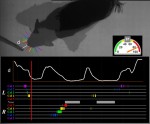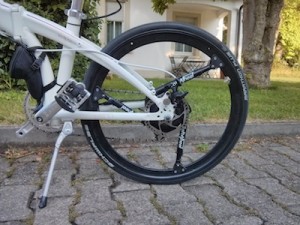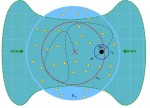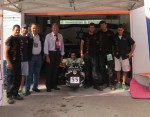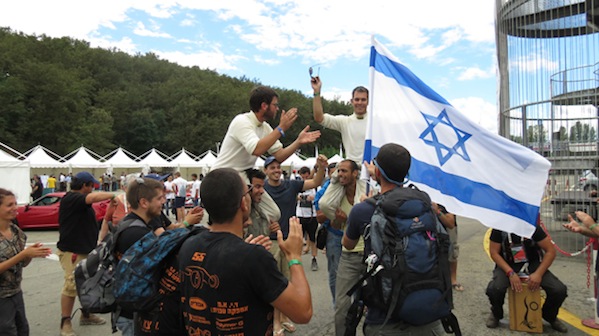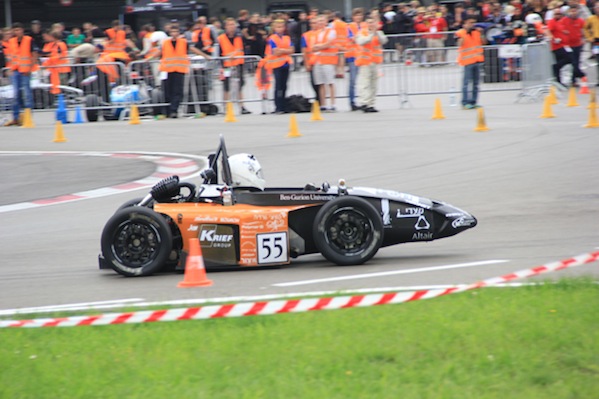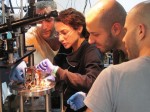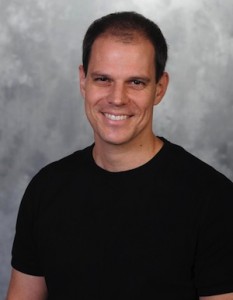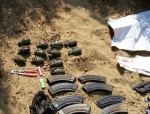Measuring the response to novelty: A mouse repeatedly touches the object and pulls away (nose and whisker contacts are color-coded; d is the distance of the snout from the object). (photo from wis-wander.weizmann.ac.il)
Put a young child in a new playground and she may take awhile to start playing – approaching the slide and then running back to Mom before finally stepping on. A new model suggests that it is not fear that makes her run back and forth, but simply the fact that her brain is telling her to stop and take in the new information – the height of the slide or how slippery it appears – before going any further.
Drs. Goren Gordon and Ehud Fonio, and Prof. Ehud Ahissar, believe that this is a basic pattern in mammals that governs how we learn. The mathematical model they developed and tested in experiments suggests that our innate curiosity is tempered by mechanisms in our brains that curb our ability to absorb novelty.
In Ahissar’s lab in the institute’s neurobiology department, researchers investigate how animals sense their surroundings. Previous research in which Fonio participated showed that, in a new situation, a mouse would approach an unfamiliar space, retreat to familiar surroundings, and then approach again. When Gordon, Fonio and Ahissar examined how mice used their whiskers to feel out a novel object, a similar pattern ensued: the whisker would touch the object, pull back and then touch it again. Gradually, as the mouse became familiar with one part of its surroundings, it would begin to explore further, moving away from the known part. The pattern was so consistent, the researchers thought they could create a model to explain how a mouse – or another mammal – explores new surroundings.
The researchers based their model on the premise that novelty can be measured and that the amount of novelty could be a primary factor in shaping the way that a mouse – or its whisker – will move through an environment. This model successfully reproduced the results of the previous study, in which the movement of the mouse gradually became more complex through the addition of measurable degrees of freedom. For example, it began with movement along a wall, as opposed to traveling across the open space. Using data from the previous experiments and others for which such data were available, they were able to construct a model that required very few additional assumptions.
The model suggested that novelty, per se, was not the deciding factor, but rather how much the novelty varied within a given situation. Approaching and retreating appear to be a way to keep the amount of new information within a constant range. Like the wavering child in the playground, the mice would absorb a certain amount of new sensory input – the curve of a new wall, for example – retreat, and approach again once the novel information was already starting to become familiar.
To test the model, the researchers designed an experimental setup in which a family of mice was born and raised in a den, and then a gate was opened from the den to a new area in which the pups could freely explore and return to their familiar den. The researchers found that the model was able to predict how the mice would explore their new surroundings. It held true whether it was applied to locomotion or to the motion of whiskers in feeling out new objects. The initial movements explored the most novel features of the new environment. After those were learned, just as the model predicted, the animals moved further afield, exploring the still-unknown parts of their surroundings.
“The mice were not given rewards for their behavior – for them, as for humans, satisfying curiosity is its own reward,” said Gordon.
“This behavioral pattern enables the mice to control the level of sensory stimulus to their brains by regulating the amount of novelty they are exposed to,” added Fonio.
These limits to novelty and exploration may, of course, have another evolutionary advantage: while the urge to explore is necessary for animals that must seek out food, stopping to check out the surroundings a bit at a time could be a prudent survival strategy. In other words, curiosity may have killed the cat, but a whisker pulled back in time might save the mouse.
Does this model apply to humans? Gordon points out that when we learn a new subject, we often need time to think things over before going on to the next topic. Further research might reveal whether young children – babies just learning to crawl, for example – explore their new surroundings in the same way. Even an adult entering a new situation might undergo a similar process.
In the future, a mathematical model of learning might prove useful for teachers and students, as well as for research into neurological issues involving the ability to absorb new information. This model also might someday be used in the field of robotics: robots that learn on their own, like mice, to explore a new setting might be able to function in situations that are too dangerous for humans, such as the aftermath of an earthquake or a nuclear power plant accident, for example.
For more Weizmann Institute news releases, visit wis-wander.weizmann.ac.il.

